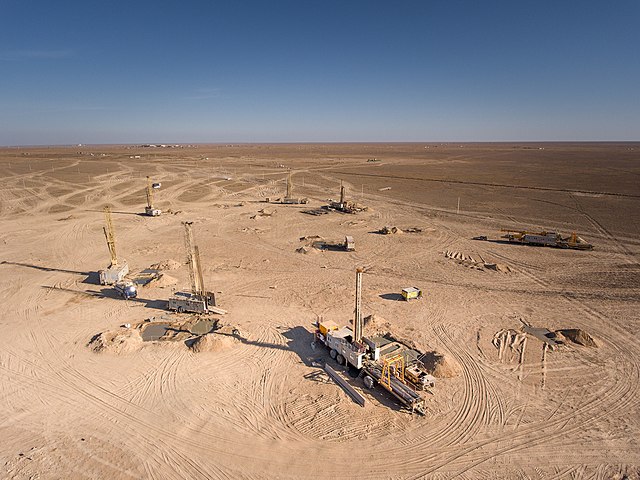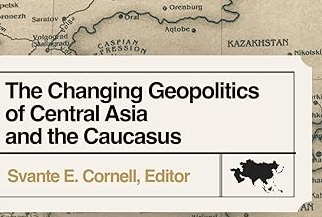By Sergey Sukhankin
In early January 2025, operations at the uranium-producing Kazakhstan-based Joint Venture Inkai LLP (JV Inkai) were temporarily halted – the venture, established in the early 1990s, has been jointly managed by Kazatomprom (which holds a 60 percent stake) and the Canadian company Cameco (with 40 percent) – resulting in a brief decline in the share prices of both firms in New York and evident concern among Canadian investors. After a short interruption, activities at Inkai resumed without disruption. This event – though seemingly a minor occurrence that largely escaped the attention of many analysts – reflects broader and more concerning trends (particularly for the West) emerging within the global uranium market, in which Kazakhstan plays a pivotal role.

Photo source: NAC Kazatomprom JSC
BACKGROUND: The strategic significance of uranium extends well beyond its military applications. The rapidly increasing global interest in nuclear energy—among both economically advanced and developing countries—is contributing to uranium’s emergence as a commodity of critical strategic value. According to estimates by the International Energy Agency (IEA), in addition to the existing 420 nuclear reactors worldwide, 63 new reactors are currently under construction, and the operational lifespan of a further 60 reactors is being extended. As a result, uranium's importance is projected to grow steadily in the years ahead. The present and future stability of the global nuclear energy sector is therefore highly contingent upon reliable access to substantial, readily extractable uranium reserves located in politically stable and predictable nations. It is precisely in this context, however, that significant challenges begin to surface.
Following the onset of Russia’s aggression against Ukraine in February 2022, Western access to two critical sources of both enriched and unenriched uranium has been partially obstructed. U.S. sanctions targeting Russian uranium have jeopardized U.S. access to this supply, while geopolitical instability—marked by a pronounced anti-Western orientation—in Sub-Saharan Africa, particularly in Niger, has effectively severed France’s access to locally sourced unenriched uranium. Exacerbating this situation, other major African uranium producers, including Namibia and Tanzania, are increasingly inclined to cooperate with Russia and China in uranium extraction activities. This emerging alignment places them in growing opposition to Western companies and their strategic interests.
At present, the already limited list of geopolitically stable, world-class uranium-producing nations has effectively narrowed to just three: Kazakhstan, Canada, and Australia. Among them, Kazakhstan stands as the global leader in the production of unenriched uranium, accounting for over 40 percent of total global output, and ranks as the second-largest country in terms of uranium reserves.
The primary concern lies in the fact that, despite its considerable wealth in natural resources, Kazakhstan is unable to fully leverage its vast resource potential. The country remains heavily dependent on two dominant geopolitical actors—Russia and China—both of which exert significant influence over the direction and development of Kazakhstan’s uranium-producing sector. Most critically, these two states maintain increasingly strained relations with the West.
Consequently, certain Kazakhstan-based analysts have voiced suspicions that the underlying cause of the operational halt at Inkai was pressure exerted by Russia, allegedly in response to Kazakhstan’s post-2022 efforts to alter the logistics of its uranium exports by decreasing reliance on Russian transit routes and instead utilizing the Trans-Caspian International Transport Route (commonly referred to as the Middle Corridor) as an alternative to exporting uranium through Russian territory.
IMPLICATIONS: The global uranium industry is currently characterized by rapidly increasing demand alongside growing uncertainty regarding the reliability of supply, driven largely by global and regional geopolitical disruptions. Within this context, Kazakhstan’s role as a resource-rich and historically stable supplier of uranium has acquired a qualitatively new significance. Notably, Kazakh authorities have publicly committed to boosting uranium production in 2025 and to diversifying both their export destinations and logistical routes, aiming to reduce the country's reliance on Russia. Nevertheless, the “Inkai incident”—which allegedly represents only the visible portion of deeper structural dynamics affecting Kazakhstan’s uranium sector—raises three key concerns.
First, can Kazakhstan successfully restructure its existing logistical routes and thereby reduce its strategic dependence on Russia? On the surface, such a shift appears feasible. According to statistics provided by Kazakh authorities, the country has made tangible progress in increasing uranium shipments through the Middle Corridor. Available data indicate that approximately 64 percent of West-bound uranium exports are now transported via this route. Moreover, Kazakhstan has also expanded its uranium exports to Western markets, with shipments destined for the United States gaining particular prominence.
The reality, however, appears significantly more complex. Despite recent efforts to diversify transit routes, a substantial portion of Kazakhstan’s uranium exports continues to be transported through Russian territory. Furthermore, Russia’s state-owned corporation Rosatom maintains (in)direct control over at least five of Kazakhstan’s fourteen major uranium production sites, reinforcing Russia’s strategic influence over the sector. In addition, the Middle Corridor presents notable challenges. Geopolitically, Georgia—an essential transit country along the route—occupies a critical position, and its political leadership has demonstrated increasing alignment with Moscow, potentially complicating matters should Russo-Western relations further deteriorate. From a logistical standpoint, representatives of the Canadian firm Cameco have expressed concerns, stating that the Middle Corridor “has proven to be neither reliable nor predictable,” due to the complex network of countries traversed and the numerous permits required for transit.
Compounding these challenges is the apparent ambivalence within Kazakhstan regarding the exclusion of Russia from its current uranium transportation framework. Specifically, Kazakh officials have indicated that the country does not intend to significantly expand the use of the Middle Corridor for uranium exports. Additionally, many Kazakhstan-based experts express skepticism about any prospective reduction in cooperation with Rosatom (i.e., Russia). On the contrary, a prevailing view among these analysts is that bilateral collaboration in the uranium sector is likely to deepen in the future.
Second, what is the actual role of China in Kazakhstan’s uranium industry and how will this role evolve? At present, China is the world’s second-largest consumer of uranium, following the United States, and its demand is expected to continue rising. Kazakhstan serves as China’s primary source of uranium: according to several studies, over half of Kazakhstan’s uranium output is currently exported to China, with some estimates suggesting this figure may be as high as 60 percent. This situation, as noted by representatives of major Western uranium-related enterprises, “raises concerns about reduced availability for Western markets, potentially exacerbating global supply constraints,” a challenge that is already beginning to manifest within the industry.
Rosatom-affiliated Uranium One Group recently concluded an agreement with the Chinese firm SNURDC Astana Mining Company Limited, a subsidiary of the State Nuclear Uranium Resources Development Co., Ltd. Under this arrangement, the Russian side transferred its shares in uranium-producing sites located in Northern Kazakhstan (Northern Khorasan) to its Chinese counterparts. At present, there is no consensus among experts regarding China’s rationale for acquiring stakes in what is considered a relatively depleted and comparatively minor uranium production site.
While some analysts contend that the acquisition primarily serves China’s geoeconomic objectives—particularly in light of projections indicating a substantial increase in the country’s uranium consumption over the coming years—others emphasize a more overtly geopolitical dimension to China’s actions. Notably, Stanislav Pritchin of the Central Asia Department at the Institute of World Economy and International Relations of the Russian Academy of Sciences has drawn attention to China’s established practice of acquiring “unpromising” oil and natural gas deposits. In his view, such acquisitions function as instruments for expanding China’s strategic presence within the host country.
Third, what is the future role of Western companies in Kazakhstan’s uranium industry? Given that neither China nor Russia appears willing to reduce their involvement in the sector—thereby sustaining Kazakhstan’s strategic dependency on both actors—serious concerns have emerged regarding the potential marginalization or even eventual withdrawal of Western firms from the country’s uranium landscape. Indeed, some Kazakhstan-based experts have implicitly acknowledged a widely discussed notion circulating in Western policy and business circles: the ongoing bifurcation of the global uranium industry. This refers to the emergence of a distinct segmentation of uranium supply chains along geopolitical lines, with one stream aligned with the West and the other with the China-led bloc. Within this context, it is feared that Kazakhstan may ultimately be compelled to align more closely with the latter and reduce its cooperation with Western partners accordingly.
Undoubtedly, such a scenario would only be likely to materialize in the event of a further deterioration in political and economic relations between China (and, under certain conditions, Russia) and their Western counterparts. While this scenario remains hypothetical at present, it is by no means implausible.
CONCLUSION: Although Kazakhstan and its political leadership have expressed strong interest in expanding foreign—particularly Western—participation in the country’s uranium industry, the influence of external geopolitical dynamics cannot be overlooked. As uranium increasingly assumes a role in the global energy mix comparable to that historically occupied by fossil fuels, the issue of access to and supply of this resource has transcended purely economic considerations and has firmly entered the realm of geopolitics.
In light of the intensifying geopolitical competition between East and West over access to emerging markets and spheres of influence, it is conceivable that China and its strategic partners may seek to curtail Western access to Kazakhstan-based uranium—mirroring developments in Sub-Saharan Africa, where Western firms are increasingly being displaced from uranium-related ventures. To avert a potential supply shock—akin to that experienced in the oil and natural gas sector following Russia’s attempt, in the aftermath of February 2022, to weaponize hydrocarbon exports as a means of exerting geopolitical pressure on the West—it is imperative that Western companies (and, arguably, governments) begin to explore alternative uranium sources to sustain their nuclear energy agendas. Given the small number of globally significant suppliers, increased attention should be directed toward Canada and Australia, which possess substantial uranium reserves and are regarded as geopolitically stable and reliable partners.
AUTHOR BIO: Dr. Sergey Sukhankin is a Senior Fellow at the Jamestown Foundation and the Saratoga Foundation (both Washington DC) and a Fellow at the North American and Arctic Defence and Security Network (Canada). He teaches international business at MacEwan School of Business (Edmonton, Canada). Currently he is a postdoctoral fellow at the Canadian Maritime Security Network (CMSN).




 Silk Road Paper S. Frederick Starr,
Silk Road Paper S. Frederick Starr,  Book Svante E. Cornell, ed., "
Book Svante E. Cornell, ed., "